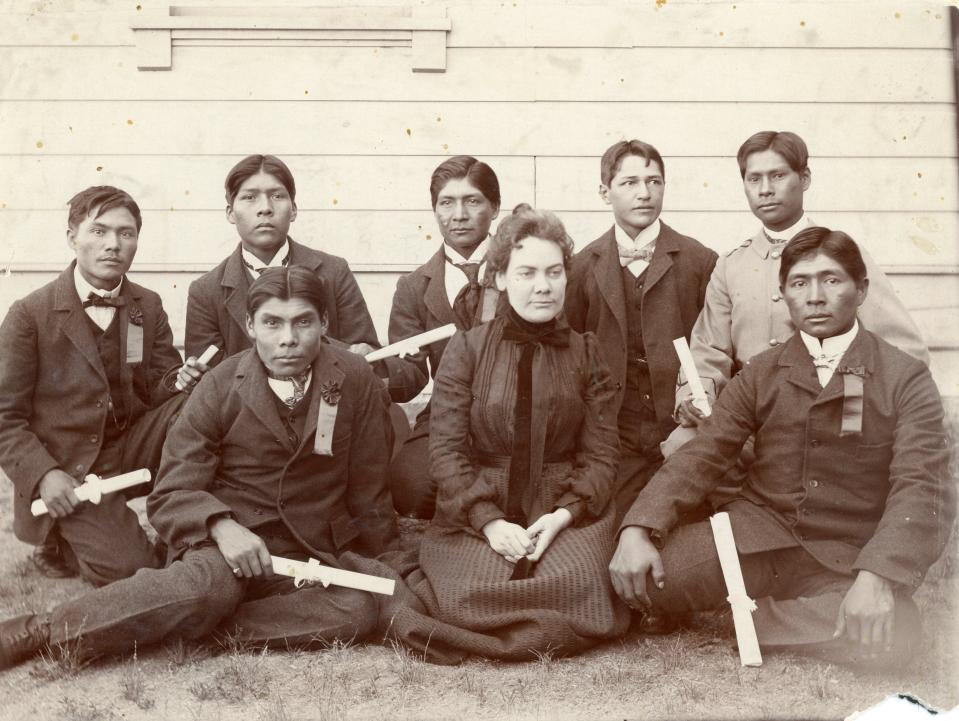Feds may investigate Native American boarding school in Nevada after discovery of Canadian mass graves
RENO, Nev. – The Stewart Indian School in Carson City may come under federal review following U.S. Interior Secretary Deb Haaland's announcement that the government will investigate its past oversight of Native American boarding schools.
Last month, Haaland, who is a member of New Mexico’s Laguna Pueblo and the first Native American to serve as a Cabinet secretary, outlined the national initiative while addressing members of the National Congress of American Indians during its midyear conference.
The initiative stemmed from the discovery of a mass grave containing the remains of 215 children, all uncovered on the site of what was once Canada’s largest Indigenous residential school. The Kamloops Indian Residential School is one of many institutions that held Indigenous children taken from families across the nation and in the United States.
The Nevada school housed thousands of students during its 90 years of operations, and local tribe members recall family members who repeatedly ran away from the school after being forcibly cut off from their families, culture and languages.
The Nevada Indian Commission has been collecting information on the history of the former Stewart Indian School, said the commission's executive director, Stacey Montooth.
Montooth said the Nevada Indian Commission has not yet received direction from the U.S. Department of Interior. Still, the state agency is “committed to following the lead of our alumni and our tribal leaders on how they want to pursue outcomes,” she said.
Mass grave of 215 children in Canada: A stark reminder of the dark history of Native American boarding schools in US
Marieval Indian Residential School: Groups report discovery of 751 bodies at Indigenous school in Saskatchewan
“The news that has grabbed the world’s attention about the findings in Canada at their residential school, it’s not surprising to Native American people,” Montooth said. “But the lack of surprise doesn’t make this any easier to deal with.”
Haaland previously said the investigation will help “uncover the truth about the loss of human life and lasting consequences of the institutions."
The unprecedented initiative will include compiling and reviewing decades of records to locate past boarding schools, unearth known and possible burial sites at or near those schools, and identify the students’ names and tribal affiliations.
Earlier this week, Montooth spoke with other tribal leaders from other parts of the country who have been working to identify missing students from boarding schools.
The discovery in Canada prompted a national discussion about atrocities against Native American communities in the U.S., Montooth said.

A look back at the Stewart Indian School
The Stewart Indian School opened Dec. 17, 1890, shortly after the first Indian boarding school in the country was established in Pennsylvania. It initially had three teachers and 37 students from the local Washoe, Paiute and Shoshone tribes. The school sat 3 miles southeast of Carson City and encompassed 240 acres.
Montooth said the U.S. waged wars against Native American communities following a failed treaty period.
“They basically tried to kill all of the Indians, and that didn’t work," she said
The next approach involved assimilation. Montooth said the school, which stayed open for 90 years, was operated like a military academy, with the goal of assimilation.
The campus opened with a capacity for 100 students. It included a Victorian-style wood-framed dormitory and schoolhouse. As enrollment increased, new buildings were added to including a place for training, a recreation room and a hospital.
According to the cultural center’s website, a railroad stop was established in 1906 to deliver supplies and transport students to and from the school. By 1919, 400 students attended the school. Vocational training remained the school’s focus until it shifted to academics in the late 1960s.
“In 2021, we would call that kidnapping,” Montooth said. “Federal representatives of the government would physically, harshly take children and rip them from their mothers’ arms and bring them to boarding schools where they were beaten for speaking their language."

She recalled hearing a story from a local elder who described several attempts at escaping Stewart Indian School.
The woman told Montooth the school matrons cut her hair every time they brought her back to the school.
“Hair to Native people is just absolutely sacred,” Montooth said. “She said she looked like a boy because it kept getting chopped and chopped.”
Budget cuts and earthquake safety issues eventually forced the school’s closure in 1980.
The state acquired the campus in the '90s, and it is now being used by the state for classes, training and agency offices.
The Washoe Tribe of Nevada and California founded the Stewart community on much of the former school’s land, according to the cultural center’s website.
Meanwhile, the school has since been listed on the National Registrar of Historic Places. The cultural center and museum is in the former administration building.
Contributing: USA TODAY; the Associated Press
This article originally appeared on Reno Gazette Journal: Native American boarding school: Haaland may review Nevada school

 Yahoo Movies
Yahoo Movies 
